
Francis Massen, meteoLCD
vantage_calibration.html version 1.0 16 Feb 2003
 |
A
short calibration study of the Vantage Pro Plus weatherstation Francis Massen, meteoLCD vantage_calibration.html version 1.0 16 Feb 2003 |
|
Abstract |
A 20 day long intercomparison between a Vantage Pro Plus weatherstation from Davis and the (professional grade) instruments of meteoLCD shows excellent to good behaviour of the Vantage Pro Plus. Solar and UVB sensors deliver fair results, but one should always keep in mind the more modest accuracy of these inexpensive radiation sensors. |
1.
Operational
procedures
A new (never used) Vantage Plus Pro weatherstation ( wireless model, to be used by Prof. A. Kies, Physics Lab, Centre Universitaire, Luxembourg) was mounted at the meteoLCD site and operated for the period from 17 Jan 2003 to 5 Feb 2003 for comparison and calibration factors (sampling interval = 30 minutes). The sensors used as a reference are those of meteoLCD (see the description).
The aim of the study is to check if the rather inexpensive and easy to setup Vantage Pro Plus, manufactured by Davis in the USA, could qualify as a valid weatherstation compared to the professional-grade sensors of meteoLCD.
Due to an operator glitch, the rain-sensor was operational only from 26 Jan, 16:00 on. The wind direction sensor was not calibrated, so it will not be used in this study. All data were imported into Statistica 6.1. for analysis and graphing; the Excel file test_davis1a.xls corresponds to these data.When calibrating the Vantage Pro Plus, an xy graph with x-axis = Vantage Pro Plus, y-axis = meteoLCD, was used; the linear regression line gives the mathematical function to apply to the Vantage readings to obtain the (assumed) correct meteoLCD values.
2. Correlation matrix

3.
Outside
(air-) temperature:
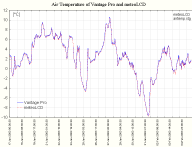 |
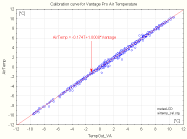 |
|
Conclusion: |
Good behaviour of the Vantage Pro sensor; scaling factor
is practically 1. Negligeable offset. |
4.
Outside (air) relative humidity
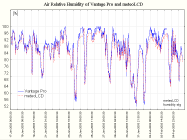 |
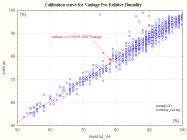 |
| Conclusion: |
Acceptable behaviour of the Vantage Pro sensor,
humidity values during wet conditions too high; scaling factor practically
0.9; offset about 6 %. |
5. Air pressure
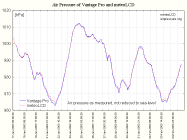 |
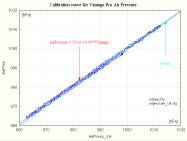 |
|
Conclusion: |
The Vantage sensor was adjusted for real air pressure
( not barometric pressure reduced to sea level) after several hours of
working (see start of upper graph). The linear regression is computed on
the remaining (comparable) data. Good behaviour of the Vantage Pro sensor:
scaling factor practically 0.97; zero-offset not relevant! |
6.
Wind velocity
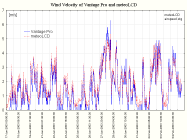 |
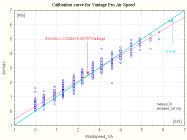 |
|
Conclusion: |
Good behaviour of the Vantage Pro sensor; scaling factor practically 0.89; negligeable offset. The sensor was mounted approx. 1 meter lower than the meteoLCD anemometer. |
7. Solar radiation
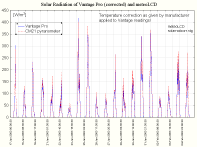 |
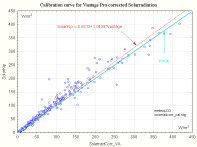 |
|
Conclusion: |
1. The meteoLCD sensor is a ventilated CM21
Kipp & Zonen pyranometer. |
8.
Effective (erythemal) UVB irradiation
The Vantage Pro applies a multilayered filter to
approximate the UVB sensors output to the CIE (Diffey) erythemal spectrum; this
approximation may be acceptable, but there exist notable deviation in the
310-320 nm region (see Davis
info).
Fine reading the specifications shows that Davis applies a (non-European)
definition of
1 MED = 220 J/m2
This should be adjusted for European comparisons, where 1 MED = 250 J/m2.
The uncorrected UVI-reading of the Vantage Pro should probably be multiplied by
220/250 (Vantage UVI ‘s are probably too high: 1 UVI is 1/40 W/m2
effective UVB; depending on the computation of the UVI (from eff. power? from
MED ?)).
There also is some confusion regarding the UVB sensor readings: what Davis calls
DOSE ( in the .pdf info-flyer) is a dose-rate in MED/hr. Only if the sampling
interval is 1 hour, dose and dose-rate are expressed by the same number. The
data column UVB shows readings that the author is incapable to decipher: it is
not effective power, as one could think. Thus the comparison is done using the
column called DOSE as representing the dose-rate, and comparing to the output of
the UVB 501A Biometer of meteoLCD.
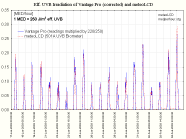 |
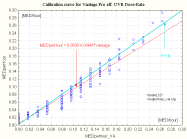 |
|
Conclusion: |
1. The meteoLCD sensor is a thermally
stabilized instrument; the Vantage Pro sensor is shielded by a ventilation
ring |
The Vantage Pro Plus is a good buy for an easy to setup
weatherstation to be used in the field (as a temporary station during a research
project) or at home.
|
Diekirch, 16th Feb. 2003 |
|
|
|
Physics Lab meteoLCD (http://meteo.lcd.lu) mailto:francis.massen@education.lu
|